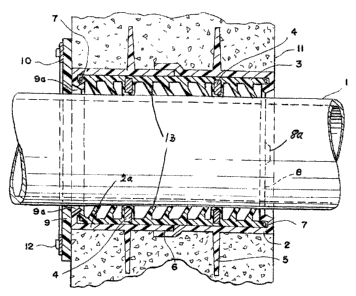Une partie des informations de ce site Web a été fournie par des sources externes. Le gouvernement du Canada n'assume aucune responsabilité concernant la précision, l'actualité ou la fiabilité des informations fournies par les sources externes. Les utilisateurs qui désirent employer cette information devraient consulter directement la source des informations. Le contenu fourni par les sources externes n'est pas assujetti aux exigences sur les langues officielles, la protection des renseignements personnels et l'accessibilité.
L'apparition de différences dans le texte et l'image des Revendications et de l'Abrégé dépend du moment auquel le document est publié. Les textes des Revendications et de l'Abrégé sont affichés :
| (12) Demande de brevet: | (11) CA 2574678 |
|---|---|
| (54) Titre français: | MANCHON POUR PREVENIR LA PENETRATION D'EAU |
| (54) Titre anglais: | HYDRO PENETRATION PREVENTION SLEEVE |
| Statut: | Morte |
| (51) Classification internationale des brevets (CIB): |
|
|---|---|
| (72) Inventeurs : |
|
| (73) Titulaires : |
|
| (71) Demandeurs : |
|
| (74) Agent: | NA |
| (74) Co-agent: | NA |
| (45) Délivré: | |
| (22) Date de dépôt: | 2007-01-22 |
| (41) Mise à la disponibilité du public: | 2008-04-17 |
| Licence disponible: | S.O. |
| (25) Langue des documents déposés: | Anglais |
| Traité de coopération en matière de brevets (PCT): | Non |
|---|
| (30) Données de priorité de la demande: | ||||||
|---|---|---|---|---|---|---|
|
A hydro penetration prevention sleeve is used
when building a basement wall wherein said basement wall is
subject to leakage from ground water especially pipes that
have to be placed through the wall. The pipe, mostly a
sewage pipe, has to be placed into the wall at a height
which is just above the sewage pipe located outside the
building or house so that gravity can carry the sewage
toward the outside pipe. A main sleeve is placed into a
concrete casing that will form the wall just prior to
casting the concrete into the casting. The sleeve consists
of PVC and is made of two halves that interfit with each
other and are glued together to accommodate any preset
dimension that matches the preset dimension of the concrete
forms prior to casting. The main sleeve has an interior
hard rubber sleeve that has rings extending to an interior
of the sleeve and the rings are slanted in the direction of
the insertion of the pipe to be inserted therein. When the
pipe is inserted therein, the slanted rings are compressed
by the pipe. The pipe cannot be moved into the opposite
direction because of the compression and friction of the
rings. There are other elements used in sealing the ends
of the main sleeve. One embodiment can be used to seal
pipes against concrete in existing installations.
Note : Les revendications sont présentées dans la langue officielle dans laquelle elles ont été soumises.
Note : Les descriptions sont présentées dans la langue officielle dans laquelle elles ont été soumises.

Pour une meilleure compréhension de l'état de la demande ou brevet qui figure sur cette page, la rubrique Mise en garde , et les descriptions de Brevet , États administratifs , Taxes périodiques et Historique des paiements devraient être consultées.
| Titre | Date |
|---|---|
| Date de délivrance prévu | Non disponible |
| (22) Dépôt | 2007-01-22 |
| (41) Mise à la disponibilité du public | 2008-04-17 |
| Demande morte | 2011-01-24 |
| Date d'abandonnement | Raison | Reinstatement Date |
|---|---|---|
| 2010-01-22 | Taxe périodique sur la demande impayée |
| Type de taxes | Anniversaire | Échéance | Montant payé | Date payée |
|---|---|---|---|---|
| Le dépôt d'une demande de brevet | 200,00 $ | 2007-01-22 | ||
| Taxe de maintien en état - Demande - nouvelle loi | 2 | 2009-01-22 | 50,00 $ | 2009-01-22 |
Les titulaires actuels et antérieures au dossier sont affichés en ordre alphabétique.
| Titulaires actuels au dossier |
|---|
| STASKAL, JEFFERY GENE |
| Titulaires antérieures au dossier |
|---|
| S.O. |